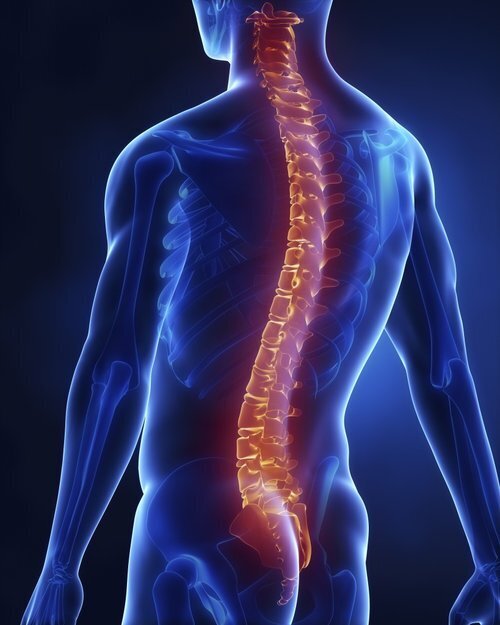Structure & Space: An Ode to the Spine [Article]
Perfect Engineering
Ah the spine. What a magical feat of engineering it is!
The spine is more than just a stack of bones. It includes perfectly designed spaces to protect nerve bundles, exquisite curves to disperse loads and allow some bounce, and graceful connections to gift us a wide range of motion.
It’s a perfect blend of hard and soft, rigidity and flexibility.
The spinal column is comprised of 24 vertebrae (singular = vertebra), plus the sacrum and coccyx. The shape of these vertebrae is very special, with each anatomical part serving a specific function, such as providing attachment anchors for other tissues, or spaces to protect and house nerves. Discs between the vertebrae provide cushioning, and tough bands of tissues, the spinal ligaments, attach to the vertebrae to support its scaffolding function.
The end result is a powerful support structure, suspension system, relay station, communications network and conduit of energy.
The spinal column is the trunk of our body-tree. It is the central station that sends out vital nutrients to the rest of the body.
The spinal column is the battery of our body-engine. It enables global transmission of the electrco-chemical messages that animate us and enable sensing.
When it is functioning as it should, it’s a miracle in motion. And when it gets out of alignment, that’s when we really appreciate how much our whole life and well-being depend upon it.
Tibetan Medicine: Spine as Upstream Indicator
The spine plays an important diagnostic role in Tibetan Medicine.
Each vertebra is associated with a particular organ or psycho-bio-energetic substance (humor). The nerves originating from that vertebra eventually innervate the related organ.
To be clear, it is not necessarily a direct nerve connection from spine to organ, and there is redundancy so that, if there is damage to the spine, the organ will not become non-functional. Regardless, the spine remains vital to maintaining the health of that organ, and also acts as an upstream indicator of issues.
The vertebrae have a main point, as well as a secret point on either side. When these points become blocked, it indicates an issue with the associated organ. Often, these points are tender long before the organ “screams” at us in a way we can no longer ignore. This is the quiet whispering of the spine.
A Tibetan Medical practitioner might first take a patient’s pulse to read the state of the various organs. If they sense that there is reduced vitality in the kidneys, for example, this may be confirmed by touching the kidney-associated vertebra. Upon palpation, the patient will likely experience an uncomfortable sensation from soreness up to pain. (Note: While what I write here is true, it must also be noted that it is a simplification and not the only way that organ dysfunction manifests.)
Therefore, nurturing the mobility and spaciousness of the spine, as well as regularly tuning into its state, is a powerful tool for prevention and early detection of downstream issues.
Tantric Buddhism: Spinal Column as Conduit
According to Tibetan Medicine, something called the “life channel” is responsible for us having life; it is its basis. The life channel includes two aspects, called black and white.
There is some internal discussion about what is specifically included in the term “life channel,” but it seems to include the spinal cord as well as the vena cava + aorta.
Some conflate the life channel with the central channel (Uma), however this is not correct. Although the central channel runs up the center of the body, it is not the spinal cord and it is not the life channel.
Certain qualities arise when wind-energy and mind enters the central channel. Very different responses (not necessarily positive) are elicited when wind-energy enters the life channel. (ref. Secret Map of the Body.)
While they are not the same, their health is still intertwined. When the spine and its associated structures are blocked, there is a deterioration of the biomechanical, physiological and energetic dimensions of the body. Blocks along the spine are also associated with emotional issues. All of this impedes the flow of energy in the central channel, inhibiting us on this Tantric spiritual path.
It is also interesting to note that humans are one of the few animals on the planet with an upright spine. (Birds and kangaroos and apes are sometimes upright as well). This unique situation has been correlated with the action of the fire-accompanying wind-energy, which is located near the navel and rises upward.
It is this special alignment that enables a direct conduit between the red essence located beneath the navel and the white essence located in the brain. This opens a discussion about the practice of Tummo, which is a practice that leads to enlightenment. Can our upright spine be one of the key human features that gifts us the capacity to become enlightened?
Ah, this human body is amazing technology!
Lu Jong: Cultivating Spaciousness & Fluidity
Let’s bring it back to the practicalities of caring for our spine to optimize our health and wellbeing.
We are aware that spinal health is vitally important. We also need to acknowledge that we live in a society whose very architecture—if not consciously countered—creates conditions for prolonged, unhealthy spinal positions. The designs of our office chairs, our car seats, our bikes—all promote an unhealthy curvature, as well as a lack of opportunities to move through a full range of spinal motion.
What to do?
It is important to have a daily practice that nurtures the spine, moves it through its healthy range of movement, resets its alignment, and cultivates space.
Unfortunately, the way that some mainstream yoga is taught has the potential to cause damage over time if the body mechanics are askew. I recently heard renowned yoga teacher Donna Farhi say that she has seen a rash of yogis presenting with SI (sacro-iliac) joint issues, which she attributes to repeated wrong loading of the spine, wrong spinal-pelvic relation and misinformed cues. (Note: The SI joint is the jagged joint that connects the sacrum and the pelvis.)
Enter Lu Jong. This traditional practice is rooted in principles of Tibetan Medicine and also prepares one for more advanced tantric practices, such as Tsa Lung and Tummo.
The first group of movements, called the Five Elements Movements, specifically focuses on moving the spine gently through its range of motion, while never pushing the practitioner to go beyond current limits.
The second group of movements focuses on the musculoskeletal system and joints. Several of these movements target specific points on the spine that commonly become blocked, such as T4 and L1.
In combination with a slow speed, deep breathing, and mindful awareness, Lu Jong practice effectively reinstates an aliveness and flow to the spine.
Conclusion: Connecting Earth & Heaven
This body is a miraculous gift. It’s a far greater technology than the computer you are reading this on.
We express gratitude for this body by prioritizing its care. It’s not wise to just focus on building muscle, or what we look like on the outside. We need to go to the center of it all.
Keep your spine spacious and mobile and you have the foundation for a resilient body, balanced emotional state, and energetically charged life.
Here’s to that structure that connects us from the earth to the heavens.

